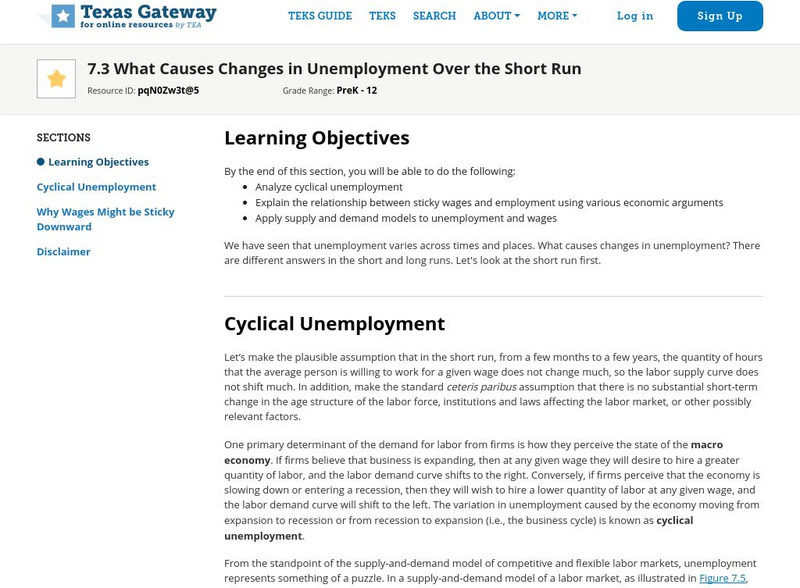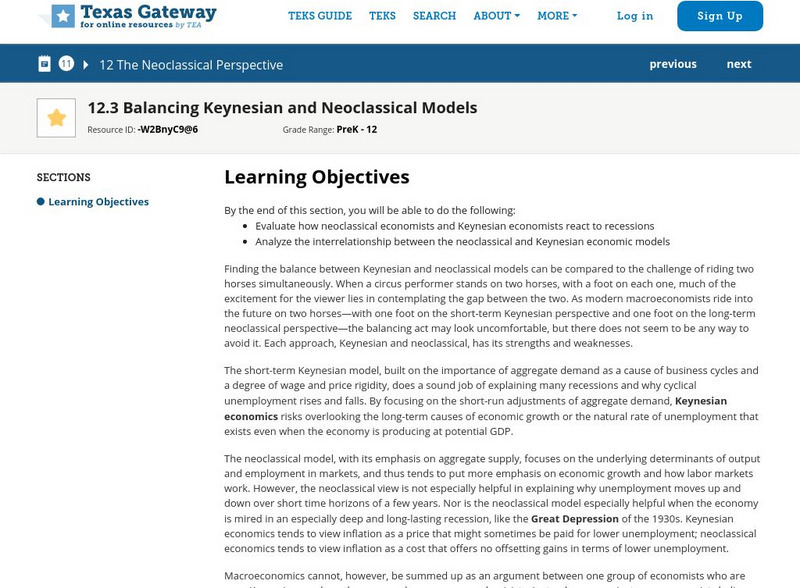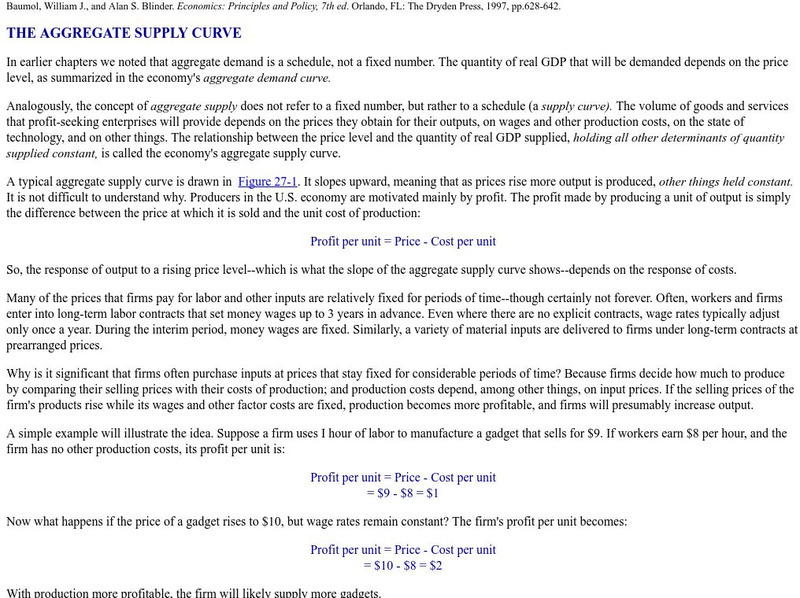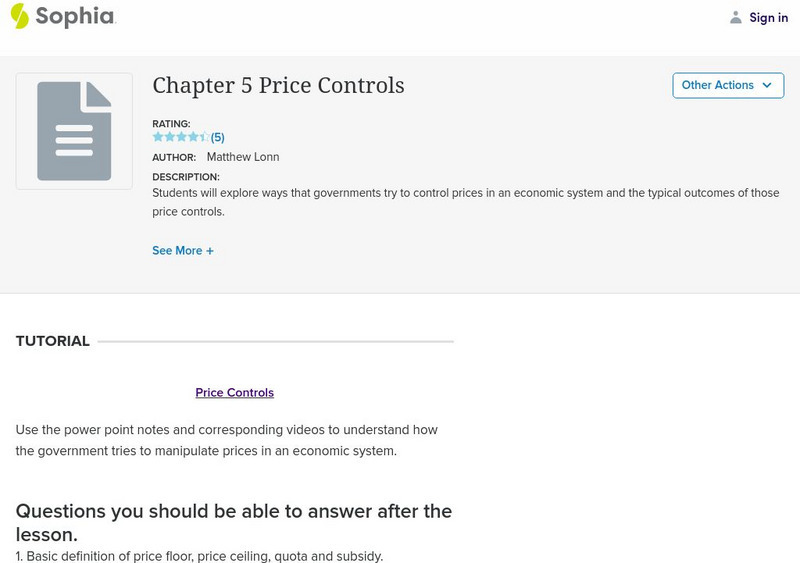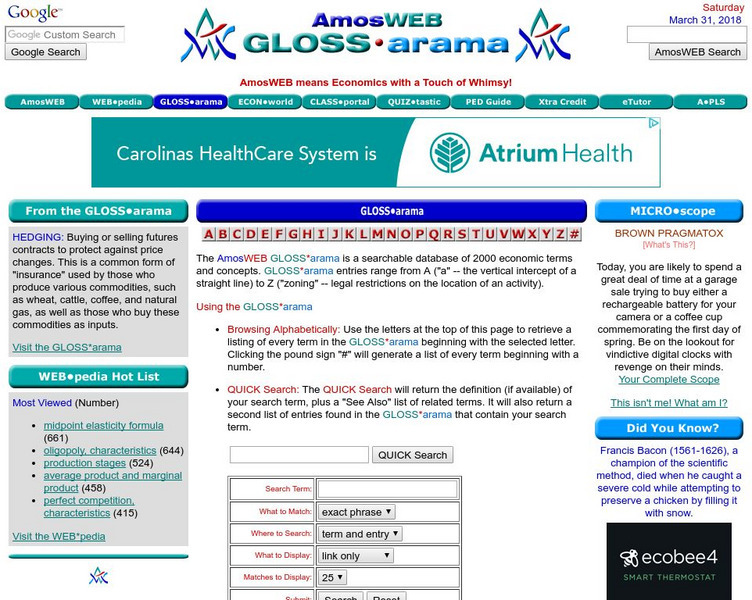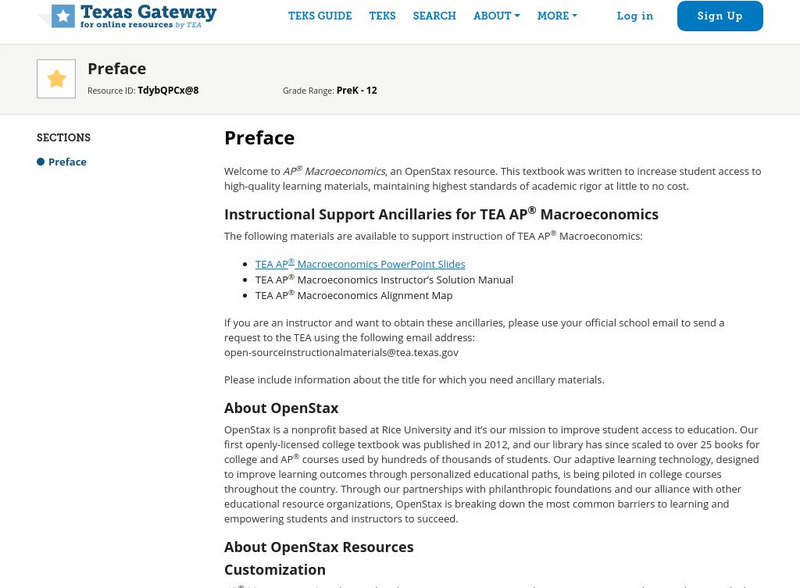University of Nebraska Omaha
Ec Ed Web: Explorations in Economic Demand
This site provides an analysis of the theory of demand, and determinants that can cause a shift or change in demand.
Council for Economic Education
Econ Ed Link: Marketplace: Price Increase or Price Gouging?
Students learn about price-gouging. Using a hypothetical post-disaster example, they will learn more about supply and demand, as well as the complexities associated with price increases in a supply-constrained market.
Khan Academy
Khan Academy: The Market Model
This study resource will help learners understand, and create, graphs that are critical skills in macroeconomics. This article reviews the market model. This resource is designed as a review for the AP Macroeconomics Test or a...
Council for Economic Education
Econ Ed Link: The Prices Are Changing
This lesson will help students to understand how markets are created by the interaction of buyers and sellers, what demand and supply are, what equilibrium price is, and how demand and supply interact with price changes.
Khan Academy
Khan Academy: Lesson Overview: Consumer and Producer Surplus
This lesson introduced the basics of a branch of economics known as welfare economics, which is interested in how the allocation of resources affects well-being. The most important concepts used in welfare analysis are total surplus and...
Khan Academy
Khan Academy: Lesson Summary: Banking and the Expansion of the Money Supply
This lesson summary from Khan Academy is intended for students who are taking the AP Macroeconomics course. In this lesson summary will review key terms and calculations related to fractional reserve banking, required reserves, excess...
Khan Academy
Khan Academy: Determinants of Price Elasticity and the Total Revenue Rule
Practice what you've learned about the relationship between price elasticity of demand and total revenue in this exercise. This resource is designed as a review for the AP Microeconomics Test or a college-level microeconomics course.
Khan Academy
Khan Academy: Price Ceilings and Price Floors
This article discusses how quantity demanded react to artificial constraints on price.
Texas Education Agency
Texas Gateway: Chapter 7: What Causes Changes in Unemployment Over the Short Run
By the end of this section, you will be able to do the following: Analyze cyclical unemployment, Explain the relationship between sticky wages and employment using various economic arguments, and Apply supply and demand models to...
Other
South Western Learning: Econ News: Comparative Statics: Perfect Competition
This site offers economics-based newspaper headlines and asks follow-up questions based on supply and demand in a perfectly competitive market.
Econoclass
Econoclass: Resources for Economic Teachers
A site with resources for teachers teaching high school economics.
Scholastic
Scholastic: Serving Up Economics
This lesson plan describes how students can use a restaurant setting to study the basic concepts of economics, while they learn business, math, and even get to eat.
Khan Academy
Khan Academy: Elasticity in the Long Run and Short Run
The elasticity of supply or demand can vary based on the length of time you care about. This resource is designed for students who are taking a college-level microeconomics course.
Council for Economic Education
Econ Ed Link: Exchange Rates and Exchange: How Money Affects Trade
Students learn how currency values are set by supply and demand, and how changes in the value of currency affect international trade. Students then find the value of the Brazilian Real in 2000 and 2002, determine whether the currency has...
University of Colorado
University of Colorado: Principles of Macroeconomics: Business Cycles, Aggregate Demand and Supply
A comprehensive look at the way aggregate demand and supply affect the business cycle. Information used is current to 2003. From the Department of Economics at the University of Colorado.
Texas Education Agency
Texas Gateway: Chapter 12: Balancing Keynesian and Neoclassical Models
By the end of this section, you will be able to do the following: Evaluate how neoclassical economists and Keynesian economists react to recessions and Analyze the interrelationship between the neoclassical and Keynesian economic models.
Other
The Aggregate Supply Curve
"The Aggregate Supply Curve," by Baumol, William J., and Alan S. Blinder. Economics: Principles and Policy, 7th ed. Orlando, FL: The Dryden Press, 1997, pp.628-642.
Other
Pure Capitalism and the Market System: The Market and the 5 Es
Learn the characteristics of a Market Economy, the state the four fundamental questions faced by any economic system. From an online textbook by Mark Healy of Harper College.
Sophia Learning
Sophia: Price Controls
Lesson uses power point notes and related videos to help students understand ways that the government tries to control prices in an economic system, and what the expected results are.
Other
Economic Glossarama: Supply
This economic glossary provides a definition of supply, and 2000 other economic terms and concepts.
University of Colorado
University of Colorado: Summary Table of Market Equilibrium
Chart that shows what happens to equilibrium price and quantity when both supply and demand remain constant or shift.
Texas Education Agency
Texas Gateway: Ap Macroeconomics: Preface
This is a preface to the TEA AP Macroeconomics Textbook online, an OpenStax resource. It provides an overview of the text, instructional materials available, the coverage and scope of the text, and the organization of the text.
Alabama Learning Exchange
Alex: Producers and Consumers
This lesson will teach the difference between producers and consumers. It provides an interactive way for students to get involved and actually become producers and consumers.
University of Nebraska Omaha
Ec Ed Web: Analyzing the Demand Curve
Lists the determinants of demand for a product and service. The site is useful for students wishing to look further into the causes of demands. Graphs and summaries are included to aid research.







